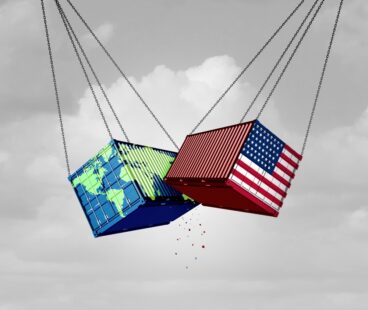April 21, 2025
Leith Wheeler Explainer Series: Trade Deficits
During his address in the Rose Garden on “Liberation Day,” Trump held up a placard with countries’ names down one side and the tariffs they would face thereafter. He stated these tariffs were meant to rectify historical wrongs committed against the United States, through two means:
- Tariffs and other taxes applied to US goods that were imported into these countries
- “Very unfair” trade practices that resulted in a trade deficit between the US and them
Let’s set aside for now the question of “fairness,” the legality of the US tariffs, and who’s right or wrong and focus on the idea of balanced trade as a goal. Implementing counter-tariffs as a tactic to level the playing field is straightforward enough, but what are trade deficits and why is President Trump so worried about them?
Trade deficits
A trade deficit occurs when a country imports more than it exports. The US may have a deficit with one country and a surplus with another. In the case of Canada, it has a trade surplus (the US exports more to us than it imports from us) on manufactured goods but a bigger deficit on energy (which it imports raw, refines, and then sells both domestically and elsewhere).

In an excellent 2023 article for Fortune
magazine Warren Buffett clearly explains why trade deficits are bad, long-term, for a country through the case of two fictional island nations of equal size, Squanderville and Thriftville. In each country, citizens work eight-hour days to produce what they need. They’re self-sufficient.
In time, Thrifters decide to work 16-hour days, eat what they need and export the rest across the channel. Squanderers happily take in these imports and pay for them by issuing bonds to the Thrifters. In the short-term, the bond issuance allows Squanderers to eat the same as before but work less, though they start accruing interest on the bonds they issued to the Thrifters.
The bond balance eventually gets large, which worries both sides. Concerned about default on the bonds they hold, Thrifters sell some of them back to the Squanderers and use the money to buy land – all the land in Thriftville – and as Buffett writes,
“At that point, the Squanderers are forced to deal with an ugly equation: They must now not only return to working eight hours a day in order to eat—they have nothing left to trade—but must also work additional hours to service their debt and pay the Thrifters rent on the land so imprudently sold. In effect, the Squanderers have been colonized by purchase rather than conquest.”
This is what Trump and his advisors are worried about – that the US’s long record of trade deficits leaves it vulnerable, that they’ve sold their country for the short-term ease and comfort of cheap goods.
When, say, China ships Americans a containerload of goods, they receive US dollars in return. Do this over and over and the capital of the US slowly leaks out into other countries, where they may use it to build industries competitive to the US. In a balanced or surplus situation – such as what existed in the US for 30 years after WWII – all those surplus dollars get put to work supporting American innovation and building American industry. Figure 1 from Buffett’s article shows the pattern clearly.
Figure 1: US trade surplus/deficits and net international investment, 1940-2023 (projected)

According to the US Treasury Department, as of April 2024 five countries held $3.3 trillion in US Treasurys, or about 40% of all foreign-owned assets.
Figure 2: Top holders of US Treasurys, April 2024

Projecting power
Historically China has squirrelled their dollars away in US Treasury bonds – to the point where they currently hold about $750 billion of US debt. If they wanted to move US interest rates up by selling some of those holdings, they could – which is what some pundits feared was happening when the yields on US 10-year Treasurys rose 0.5% to 4.6% in the week after Trump’s April 2 announcement. That’s a big move in bond markets. In practice, doing this would be a risky move for the Chinese as the holdings give them fuel to step in and support their own currency when they need to. Dumping Treasurys could also set off a panic in markets that hurts everyone, so it likely wasn’t them*.
Irrespective of how likely they are to use that leverage (pun intended), the fact remains that China’s holdings of US debt gives it to them – and puts a target on their back for retaliatory tariffs. They are the Thrifters to the US’ Squanderers.
Will the cure for trade imbalances be worse than the illness?
Figure 2 shows how manufacturing jobs flat-lined for decades at ~20 million, a period when the population grew by 2.5 times (and services jobs skyrocketed). While jobs are a bad proxy for production due to improvements in productivity, there’s no arguing that as a percentage of the US workforce, widget makers have dwindled. Given the scale of the gap, can the US actually rebuild its manufacturing base to its former glory, and what would that entail?
Figure 3: US Manufacturing and Service Jobs, 1940-2023

With the high relative labour costs in the US, it’s hard to imagine an outcome in which on-shoring does not materially increase prices for consumers, at least in the short term. Trump campaigned on lower inflation so the better question becomes: Will consumers (specifically, Republican voters) swallow the higher prices that US-produced goods will demand?
Another question on investors’ minds is: Will the tariffs (in whatever form they eventually settle) induce recessions in the US and beyond, and lower the ceiling on long-term potential growth for everyone? This risk provides another potential brake on Trump’s willingness to follow through on his threats. The trade balance may need to be restored at a more moderate pace.
At a press conference last week, US Federal Reserve Chair Jerome Powell addressed these questions, saying that the uncertainty from Trump’s tariffs “could inflict lasting economic damage... putting the economy on a path toward weaker growth, higher unemployment and faster inflation — all at the same time,” and adding “unemployment is likely to go up as the economy slows… In all likelihood, inflation is likely to go up as well. That is to say that a portion of the burden of tariffs is going to be ‘paid by the public.’” Markets sold off Wednesday on the news.
Long term
US trade deficits arose as a byproduct of globalization – a trade system established through the Bretton Woods Accord, which America presented to world leaders as they gathered to rebuild the global economies from the ashes of WWII. It was perpetuated by America, supported militarily by America, for the benefit of America (and others), until it wasn’t. Today, Trump is expediting the global divorce as the underemployed blue-collar arm of his core want globalization unwound. These measures are meant to achieve that and have long-term economic and political implications.
In his article, Buffett argues that the fictional island deal was actually fair to the current generations of both sides as today’s Squanderers worked shorter days in exchange for their land. Their kids, however, got a bit of a raw deal. They own nothing, rent everything, and are compelled to work forever without hope of building wealth. It is ludicrous to say America’s youth are in this situation. But a fear of this future is what may be motivating these dramatic moves.
* The main contributor to rising yields this month was something called the “basis trade.” The gist of it: hedge funds and other active managers bet on the difference between Treasurys and Treasury futures. Banks help them do this but in times of market turmoil, can quickly take their ball and go home. It happened in 2008 and in 2020, and it happened again in the week following the tariff announcements. Suddenly everyone scrambled to close their positions, and to do this, they had to sell their Treasury bonds. All that selling pushed prices down, and yields up. This happened at a time when one would expect bond yields to fall as investors sought safety while fleeing the stock market. A lot of attention was paid to tumbling equities but it’s notable that it wasn’t until bond yields moved higher that Trump’s Pause appeared.
Recent Posts
- Resources for Reconciliation
- Leith Wheeler: Investing in Women
- WEBINAR: Leith Wheeler in Québec
- In Conversation with Julia Chung: Advice for Your Golden Girls Era
- Leith Wheeler Establishes Montréal Office, Hires Industry Veterans Eric Desbiens and Denis Durand
- VIDEO: Leith Wheeler Outlook 2025
- WEBINAR: Home Country Bias
- Section 899: A New Cross-Border Tax Threat for Canadian Investors?
- The Leith Wheeler Podcast Playlist
- Trump, Trudeau, & the Markets



